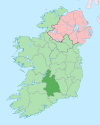Carrickbeg
Carrickbeg
An Charraig Bheag | |
|---|---|
Village | |
IST (WEST )) |
Carrickbeg (Irish: An Charraig Bheag, meaning "the small rock")[1] is a village in County Tipperary,[2] Ireland. Located on the border between counties Waterford and Tipperary, it comprises part of the town of Carrick-on-Suir that lies south of the River Suir. The area is in County Tipperary, but a minority of residents have an affinity for County Waterford, as well as it previously being a part of Waterford.
Carrickbeg came to national attention in 2008 when the winning ticket for a €15 million EuroMillions jackpot was sold in the village.[3]
History
The Franciscan order had a presence in Carrickbeg between 1336 and 2006.
Features
The main features of Carrickbeg are the old St. Molleran's church,[6] the River Suir and the views of Slievenamon.
Sport
The local
The 1998 Tour de France passed through Carrickbeg.[citation needed]
See also
References
- ^ "An Charraig Bheag/Carrickbeg". logainm.ie. Placenames Database of Ireland.
- ^ 'Carrickbeg Townland, Co. Tipperary' townlands.ie retrieved 25 November 2021
- ^ "Luck of the Irish". Euro-Millions.com. Archived from the original on 9 March 2016. Retrieved 27 January 2015.
- ^ "New Life for Carrick Friary". Irish Franciscans. Archived from the original on 28 January 2015. Retrieved 27 January 2015.
- ^ "Saint Francis Roman Catholic Church". Department of Arts, Heritage and the Gaeltacht. Archived from the original on 28 January 2015. Retrieved 27 January 2015.
- ^ "Saint Molleran's Church". Department of Arts, Heritage and the Gaeltacht. Archived from the original on 15 December 2018. Retrieved 27 January 2015.

